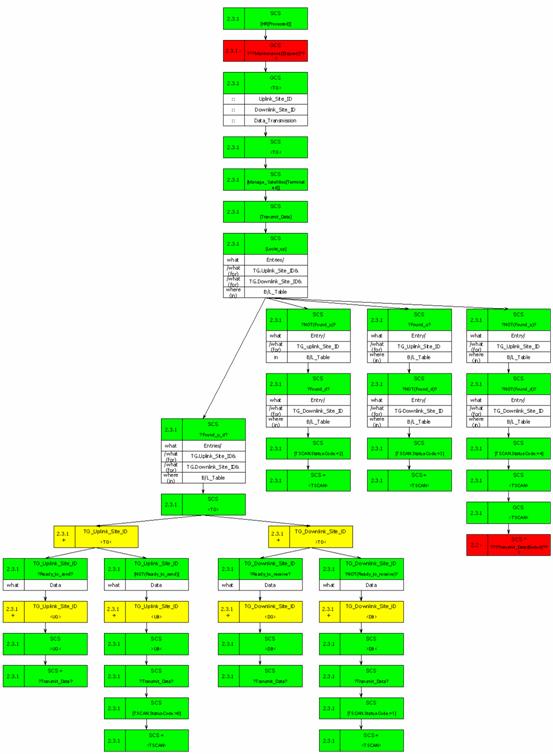Behavior Engineering Based Software Change Case Studies
Background
. Behavior Engineering
. Software Change
. Software Tools
. Microwave Oven Case Study
. Satellite Control System
Mircowave Oven Case Study
Version 1
. Requirements and RBT
. The DBT
. Other Design Diagrams
Version 2 and 3
. Version 2
. Version 3
Evolutionary Diagrams
. EVDBT for version 1,2 and 3
. Other Evolutionary Diagrams
Satellite Control System
Requirements and RBTs
. Requirement 2.1
. Requirement 2.2
. Requirement 2.2.1
. Requirement 2.2.2
. Requirement 2.2.3
. Requirement 2.3
. Requirement 2.3.1
. Requirement 2.3.2
. Requirement 2.3.3
. Requirement 2.3.4
. Requirement 2.3.5
. Design Behavior Tree
Other Versions
. Version 2 Requirement 2.2.3
. DBT for Version 2
. Version 3 Requirement 2.1
. DBT for Version 3
. Version 4 Requirement 2.2.2
. DBT for Version 4
. Version 5 Requirement 2.3.4
. DBT for Version 5
. The Evolutionary DBT
2.3.1 Establishing an Uplink/Downlink Site-SCS Connection
Once a maintenance time slot is ended, the
SCS is ready to receive "Transmit Data" transaction command and
acknowledgment messages from the GCS, the uplink site, and the downlink
site.
TG1) A TG command message shall specify the (1) the uplink site ID, (2)
the downlink site ID, and (3) the planned time slot duration.
TG2) The SCS shall receive a TG (customer data transmission time slot
go) command message from the GCS. That signals the initiation of a
"Transmit Data" transaction for a specified customer data transmission
time slot.
The current "Manage Satellites" transaction shall be terminated when
the SCS receives a TG command message.
TG3) The SCS shall look up the entries for the uplink and downlink
sites in the B/L lookup table that are specified in the TG command
message.
TG3.1) If uplink and downlink site entries are found in the B/L table,
the SCS shall forward the TG command message to the uplink site and the
downlink sites identified in the TG command message.
TG3.2) If an uplink and/or a downlink site entry is not found in the
B/L table, the SCS shall prepare and return a TSCAN (time slot
canceled) acknowledgment message to the GCS with (1) a status code of 2
if the uplink site entry is not found, (2) a status code of 3 if the
downlink site entry is not found, or (3) a status code of 4 if neither
site entry is found.
Report Site Readiness
UG1) The SCS shall receive a UG (uplink good) acknowledgment message if
the uplink site is ready to send data.
UG2) A UG may only be received during a valid "Transmit Data"
transaction.
DG1) The SCS shall receive a DG (downlink good) acknowledgment message
if the downlink site is ready to receive data.
DG2) A DG may only be received during a valid "Transmit Data"
transaction.
Connection
Attempt Failed
UB1) The SCS shall receive a UB (uplink bad) acknowledgment message if
the uplink site is not ready to receive data.
UB2) The SCS shall terminate a customer data communications time slot
for rescheduling if it receives a UB from the uplink site. Upon receipt
of a UB, the SCS shall prepare and send a TSCAN (time slot canceled)
command message with a status code of "0" to the GCS.
UB3) A UB acknowledgment may be received only during a valid "Transmit
Data" transaction.
DB1) The SCS shall receive a DB (downlink bad) acknowledgment message
if the downlink site is not ready to receive data.
DB2) The SCS shall terminate a customer data communications time slot
for rescheduling if it receives a DB from the downlink site. Upon
receipt of a DB, the SCS shall prepare and send a TSCAN (time slot
canceled) command message with a status code of "1" to the GCS.
DB3) A DB acknowledgment message may be received only during a valid
"Transmit Data" transaction.
The corresponding Requirement Behavior Tree is as below: (click the
image to see the full size graph)
